Macroeconomic Assignment: Canadian Economic Trends and Analysis
VerifiedAdded on 2021/06/14
|24
|3989
|12
Report
AI Summary
This macroeconomic assignment analyzes the Canadian economy, focusing on its performance between 2007 and 2010. It begins with an introduction to the Canadian economy, highlighting its mixed economic system, GDP trends, and growth rates. The report then delves into the period of interest, examining GDP fluctuations and the impact of the Global Financial Crisis of 2007-2009. It explores the reasons behind Canada's economic downturn and its subsequent rapid recovery, attributing the latter to the stability of the financial sector and effective government policies. The analysis incorporates the Loanable Funds Theory and the Aggregate Demand and Aggregate Supply Theory to explain the effects of interest rate regulations and their influence on investment, consumption, and overall economic activity. The report concludes by emphasizing the resilience of the Canadian economy and the effectiveness of its policy responses in mitigating the crisis's impact. The second part gives an overview of the global economic outlook and the economic outlook of Canada, with GDP predictions.
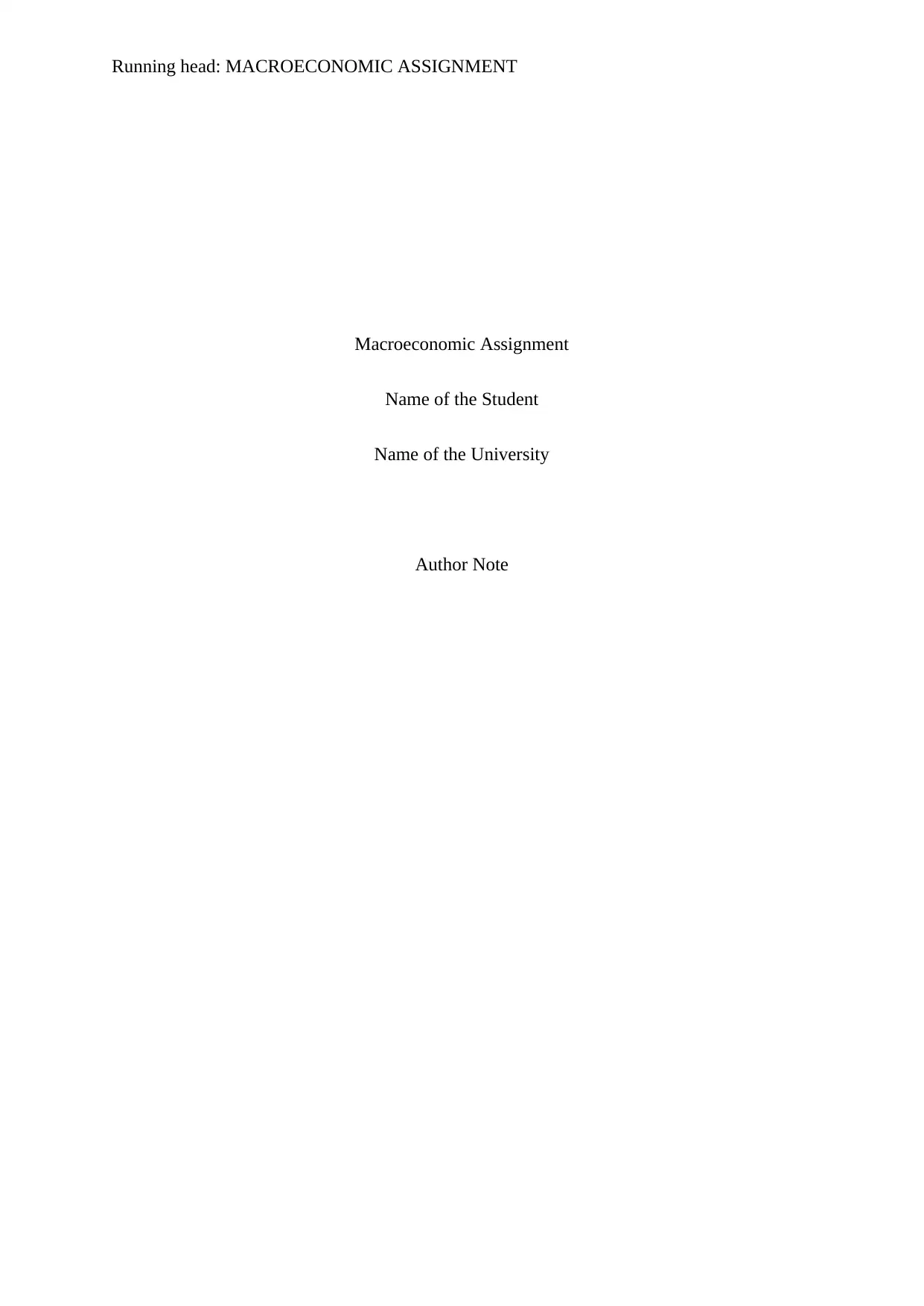
Running head: MACROECONOMIC ASSIGNMENT
Macroeconomic Assignment
Name of the Student
Name of the University
Author Note
Macroeconomic Assignment
Name of the Student
Name of the University
Author Note
Paraphrase This Document
Need a fresh take? Get an instant paraphrase of this document with our AI Paraphraser
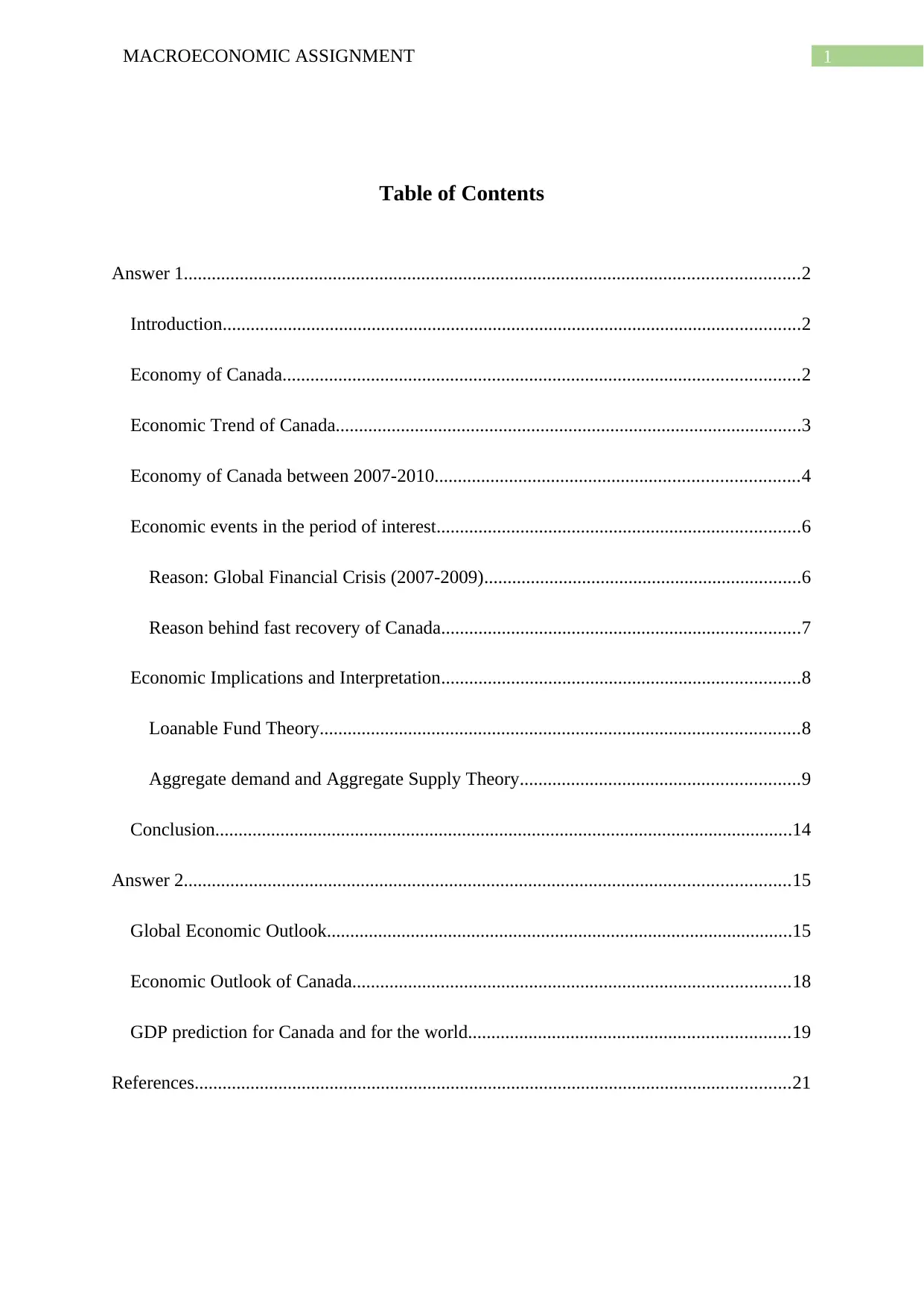
1MACROECONOMIC ASSIGNMENT
Table of Contents
Answer 1....................................................................................................................................2
Introduction............................................................................................................................2
Economy of Canada...............................................................................................................2
Economic Trend of Canada....................................................................................................3
Economy of Canada between 2007-2010..............................................................................4
Economic events in the period of interest..............................................................................6
Reason: Global Financial Crisis (2007-2009)....................................................................6
Reason behind fast recovery of Canada.............................................................................7
Economic Implications and Interpretation.............................................................................8
Loanable Fund Theory.......................................................................................................8
Aggregate demand and Aggregate Supply Theory............................................................9
Conclusion............................................................................................................................14
Answer 2..................................................................................................................................15
Global Economic Outlook....................................................................................................15
Economic Outlook of Canada..............................................................................................18
GDP prediction for Canada and for the world.....................................................................19
References................................................................................................................................21
Table of Contents
Answer 1....................................................................................................................................2
Introduction............................................................................................................................2
Economy of Canada...............................................................................................................2
Economic Trend of Canada....................................................................................................3
Economy of Canada between 2007-2010..............................................................................4
Economic events in the period of interest..............................................................................6
Reason: Global Financial Crisis (2007-2009)....................................................................6
Reason behind fast recovery of Canada.............................................................................7
Economic Implications and Interpretation.............................................................................8
Loanable Fund Theory.......................................................................................................8
Aggregate demand and Aggregate Supply Theory............................................................9
Conclusion............................................................................................................................14
Answer 2..................................................................................................................................15
Global Economic Outlook....................................................................................................15
Economic Outlook of Canada..............................................................................................18
GDP prediction for Canada and for the world.....................................................................19
References................................................................................................................................21

2MACROECONOMIC ASSIGNMENT
⊘ This is a preview!⊘
Do you want full access?
Subscribe today to unlock all pages.

Trusted by 1+ million students worldwide
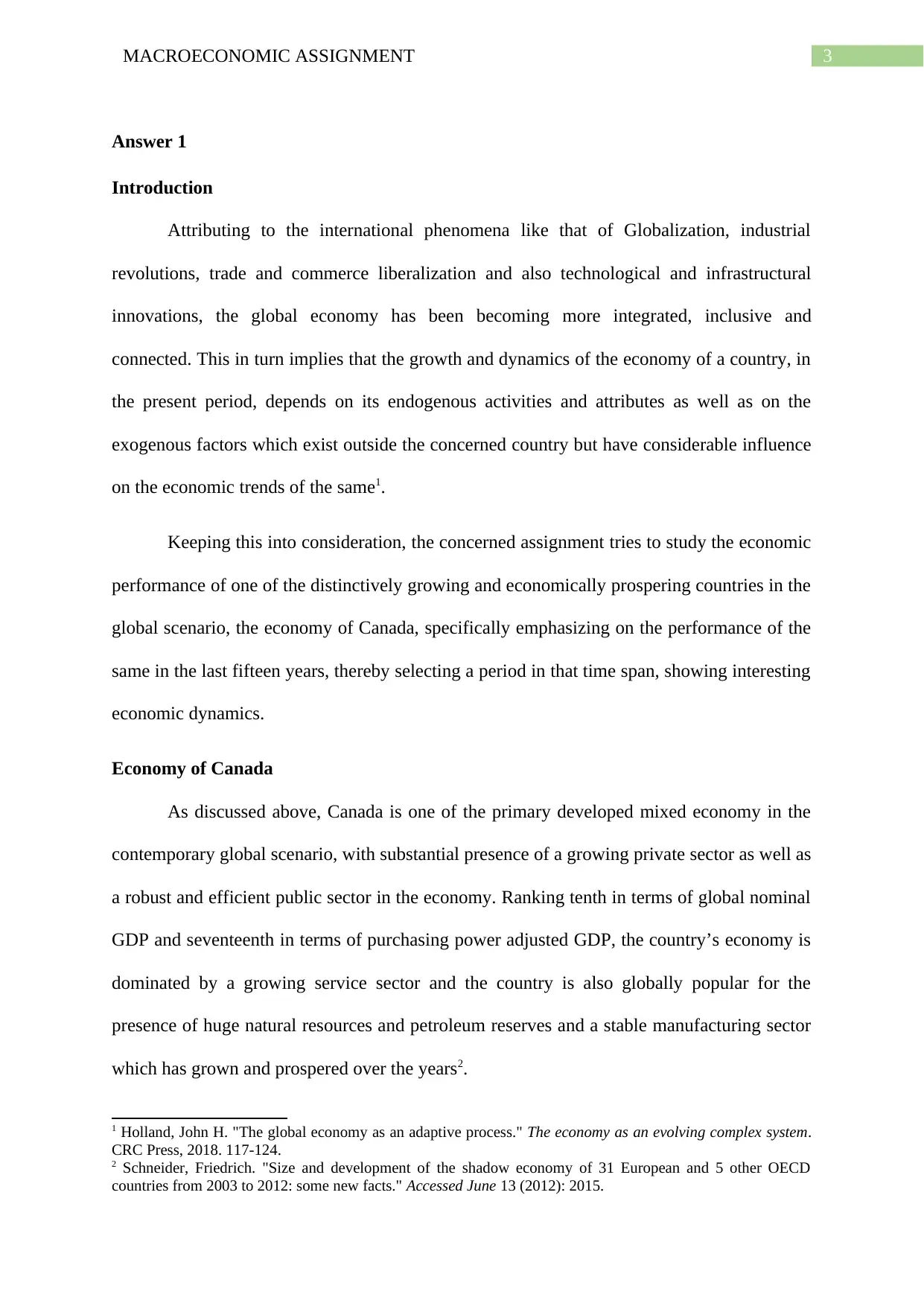
3MACROECONOMIC ASSIGNMENT
Answer 1
Introduction
Attributing to the international phenomena like that of Globalization, industrial
revolutions, trade and commerce liberalization and also technological and infrastructural
innovations, the global economy has been becoming more integrated, inclusive and
connected. This in turn implies that the growth and dynamics of the economy of a country, in
the present period, depends on its endogenous activities and attributes as well as on the
exogenous factors which exist outside the concerned country but have considerable influence
on the economic trends of the same1.
Keeping this into consideration, the concerned assignment tries to study the economic
performance of one of the distinctively growing and economically prospering countries in the
global scenario, the economy of Canada, specifically emphasizing on the performance of the
same in the last fifteen years, thereby selecting a period in that time span, showing interesting
economic dynamics.
Economy of Canada
As discussed above, Canada is one of the primary developed mixed economy in the
contemporary global scenario, with substantial presence of a growing private sector as well as
a robust and efficient public sector in the economy. Ranking tenth in terms of global nominal
GDP and seventeenth in terms of purchasing power adjusted GDP, the country’s economy is
dominated by a growing service sector and the country is also globally popular for the
presence of huge natural resources and petroleum reserves and a stable manufacturing sector
which has grown and prospered over the years2.
1 Holland, John H. "The global economy as an adaptive process." The economy as an evolving complex system.
CRC Press, 2018. 117-124.
2 Schneider, Friedrich. "Size and development of the shadow economy of 31 European and 5 other OECD
countries from 2003 to 2012: some new facts." Accessed June 13 (2012): 2015.
Answer 1
Introduction
Attributing to the international phenomena like that of Globalization, industrial
revolutions, trade and commerce liberalization and also technological and infrastructural
innovations, the global economy has been becoming more integrated, inclusive and
connected. This in turn implies that the growth and dynamics of the economy of a country, in
the present period, depends on its endogenous activities and attributes as well as on the
exogenous factors which exist outside the concerned country but have considerable influence
on the economic trends of the same1.
Keeping this into consideration, the concerned assignment tries to study the economic
performance of one of the distinctively growing and economically prospering countries in the
global scenario, the economy of Canada, specifically emphasizing on the performance of the
same in the last fifteen years, thereby selecting a period in that time span, showing interesting
economic dynamics.
Economy of Canada
As discussed above, Canada is one of the primary developed mixed economy in the
contemporary global scenario, with substantial presence of a growing private sector as well as
a robust and efficient public sector in the economy. Ranking tenth in terms of global nominal
GDP and seventeenth in terms of purchasing power adjusted GDP, the country’s economy is
dominated by a growing service sector and the country is also globally popular for the
presence of huge natural resources and petroleum reserves and a stable manufacturing sector
which has grown and prospered over the years2.
1 Holland, John H. "The global economy as an adaptive process." The economy as an evolving complex system.
CRC Press, 2018. 117-124.
2 Schneider, Friedrich. "Size and development of the shadow economy of 31 European and 5 other OECD
countries from 2003 to 2012: some new facts." Accessed June 13 (2012): 2015.
Paraphrase This Document
Need a fresh take? Get an instant paraphrase of this document with our AI Paraphraser
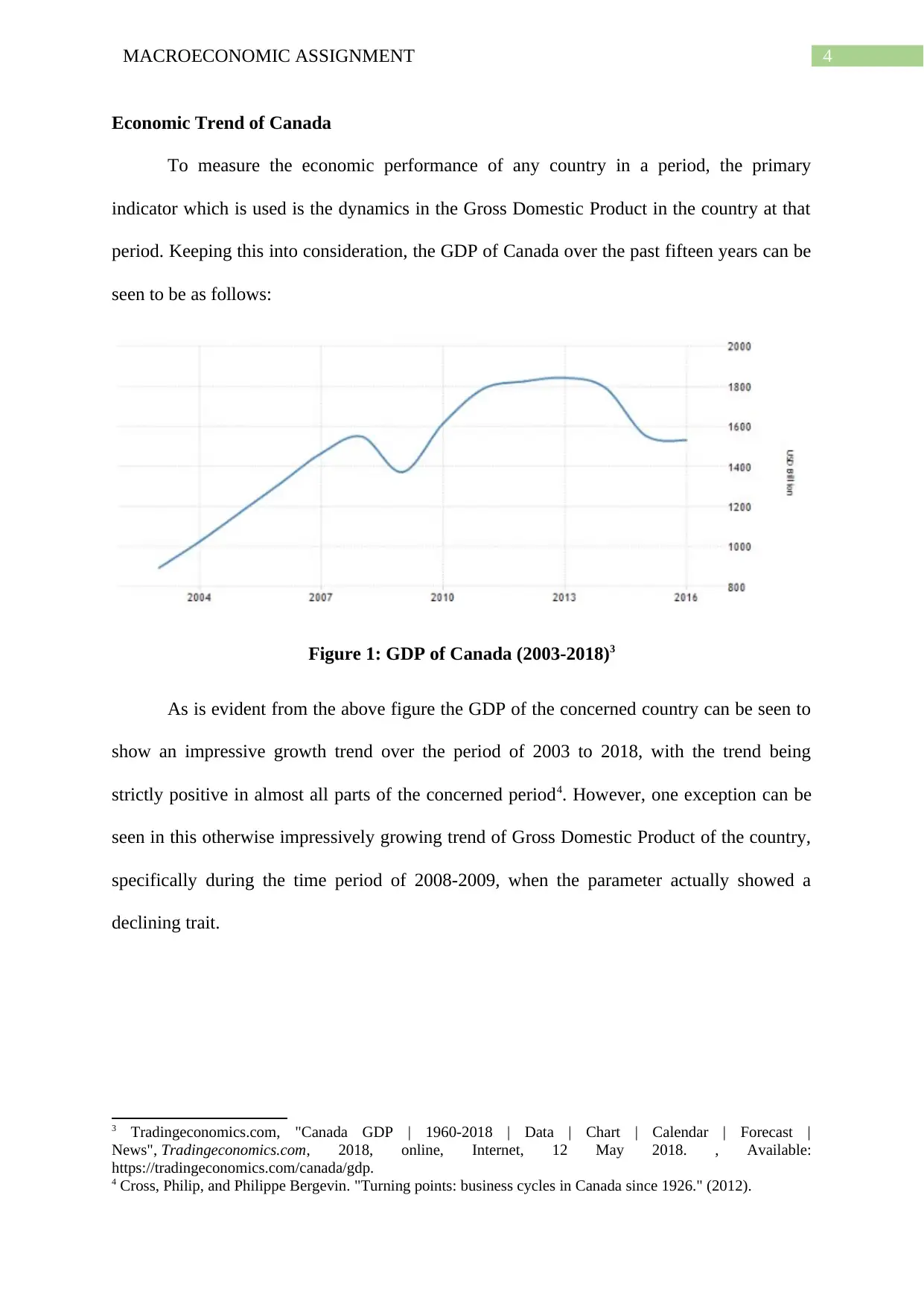
4MACROECONOMIC ASSIGNMENT
Economic Trend of Canada
To measure the economic performance of any country in a period, the primary
indicator which is used is the dynamics in the Gross Domestic Product in the country at that
period. Keeping this into consideration, the GDP of Canada over the past fifteen years can be
seen to be as follows:
Figure 1: GDP of Canada (2003-2018)3
As is evident from the above figure the GDP of the concerned country can be seen to
show an impressive growth trend over the period of 2003 to 2018, with the trend being
strictly positive in almost all parts of the concerned period4. However, one exception can be
seen in this otherwise impressively growing trend of Gross Domestic Product of the country,
specifically during the time period of 2008-2009, when the parameter actually showed a
declining trait.
3 Tradingeconomics.com, "Canada GDP | 1960-2018 | Data | Chart | Calendar | Forecast |
News", Tradingeconomics.com, 2018, online, Internet, 12 May 2018. , Available:
https://tradingeconomics.com/canada/gdp.
4 Cross, Philip, and Philippe Bergevin. "Turning points: business cycles in Canada since 1926." (2012).
Economic Trend of Canada
To measure the economic performance of any country in a period, the primary
indicator which is used is the dynamics in the Gross Domestic Product in the country at that
period. Keeping this into consideration, the GDP of Canada over the past fifteen years can be
seen to be as follows:
Figure 1: GDP of Canada (2003-2018)3
As is evident from the above figure the GDP of the concerned country can be seen to
show an impressive growth trend over the period of 2003 to 2018, with the trend being
strictly positive in almost all parts of the concerned period4. However, one exception can be
seen in this otherwise impressively growing trend of Gross Domestic Product of the country,
specifically during the time period of 2008-2009, when the parameter actually showed a
declining trait.
3 Tradingeconomics.com, "Canada GDP | 1960-2018 | Data | Chart | Calendar | Forecast |
News", Tradingeconomics.com, 2018, online, Internet, 12 May 2018. , Available:
https://tradingeconomics.com/canada/gdp.
4 Cross, Philip, and Philippe Bergevin. "Turning points: business cycles in Canada since 1926." (2012).
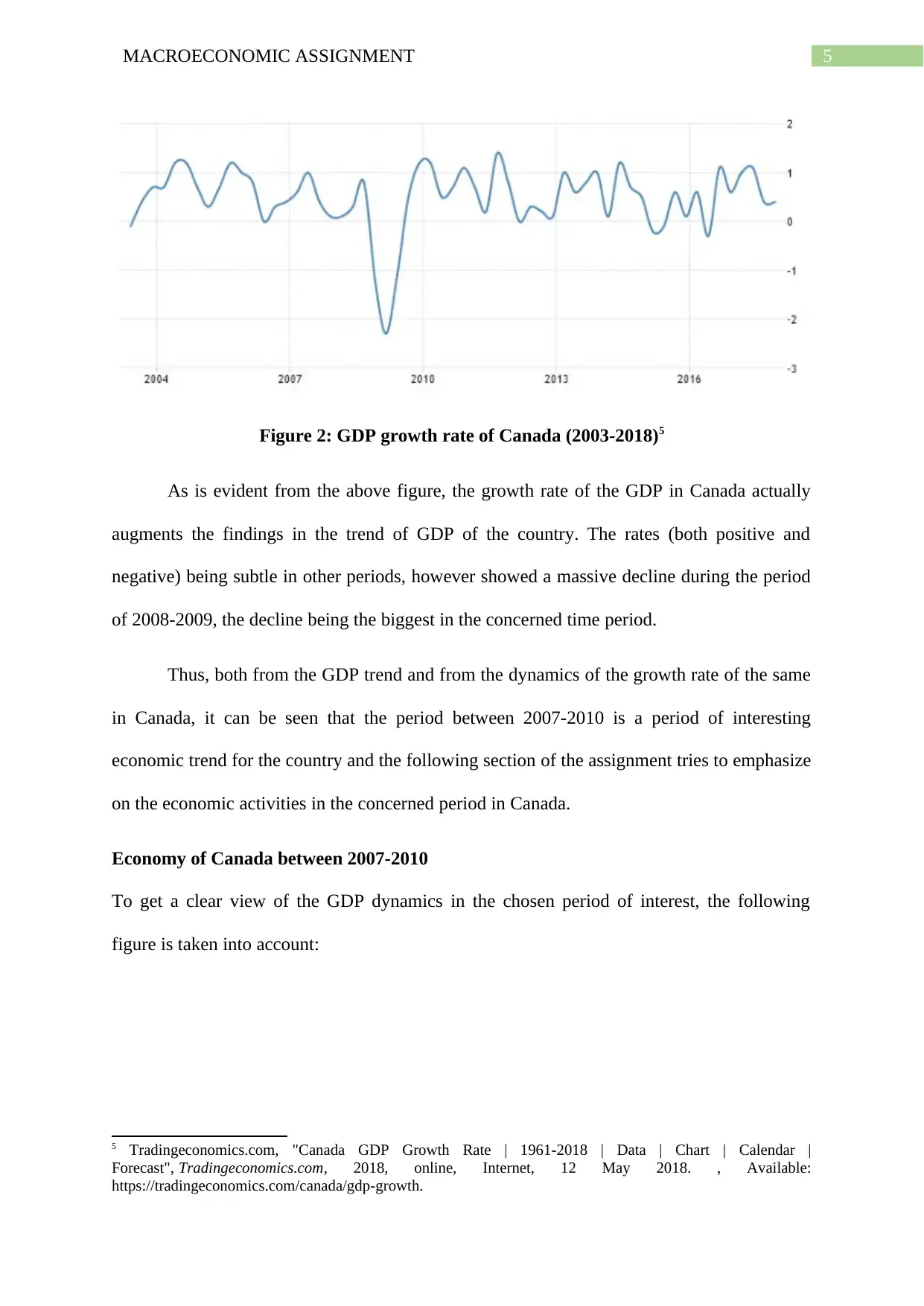
5MACROECONOMIC ASSIGNMENT
Figure 2: GDP growth rate of Canada (2003-2018)5
As is evident from the above figure, the growth rate of the GDP in Canada actually
augments the findings in the trend of GDP of the country. The rates (both positive and
negative) being subtle in other periods, however showed a massive decline during the period
of 2008-2009, the decline being the biggest in the concerned time period.
Thus, both from the GDP trend and from the dynamics of the growth rate of the same
in Canada, it can be seen that the period between 2007-2010 is a period of interesting
economic trend for the country and the following section of the assignment tries to emphasize
on the economic activities in the concerned period in Canada.
Economy of Canada between 2007-2010
To get a clear view of the GDP dynamics in the chosen period of interest, the following
figure is taken into account:
5 Tradingeconomics.com, "Canada GDP Growth Rate | 1961-2018 | Data | Chart | Calendar |
Forecast", Tradingeconomics.com, 2018, online, Internet, 12 May 2018. , Available:
https://tradingeconomics.com/canada/gdp-growth.
Figure 2: GDP growth rate of Canada (2003-2018)5
As is evident from the above figure, the growth rate of the GDP in Canada actually
augments the findings in the trend of GDP of the country. The rates (both positive and
negative) being subtle in other periods, however showed a massive decline during the period
of 2008-2009, the decline being the biggest in the concerned time period.
Thus, both from the GDP trend and from the dynamics of the growth rate of the same
in Canada, it can be seen that the period between 2007-2010 is a period of interesting
economic trend for the country and the following section of the assignment tries to emphasize
on the economic activities in the concerned period in Canada.
Economy of Canada between 2007-2010
To get a clear view of the GDP dynamics in the chosen period of interest, the following
figure is taken into account:
5 Tradingeconomics.com, "Canada GDP Growth Rate | 1961-2018 | Data | Chart | Calendar |
Forecast", Tradingeconomics.com, 2018, online, Internet, 12 May 2018. , Available:
https://tradingeconomics.com/canada/gdp-growth.
⊘ This is a preview!⊘
Do you want full access?
Subscribe today to unlock all pages.

Trusted by 1+ million students worldwide
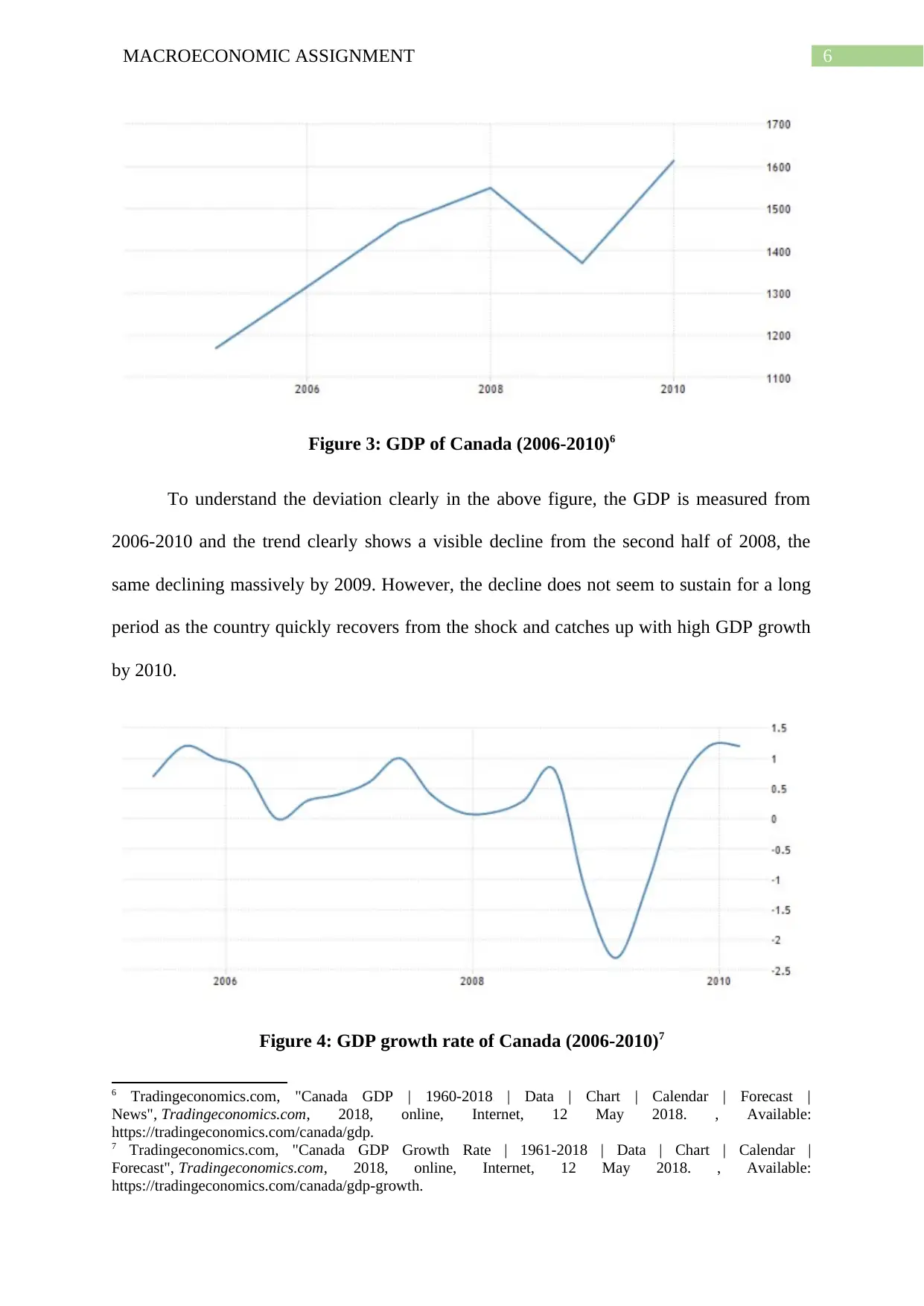
6MACROECONOMIC ASSIGNMENT
Figure 3: GDP of Canada (2006-2010)6
To understand the deviation clearly in the above figure, the GDP is measured from
2006-2010 and the trend clearly shows a visible decline from the second half of 2008, the
same declining massively by 2009. However, the decline does not seem to sustain for a long
period as the country quickly recovers from the shock and catches up with high GDP growth
by 2010.
Figure 4: GDP growth rate of Canada (2006-2010)7
6 Tradingeconomics.com, "Canada GDP | 1960-2018 | Data | Chart | Calendar | Forecast |
News", Tradingeconomics.com, 2018, online, Internet, 12 May 2018. , Available:
https://tradingeconomics.com/canada/gdp.
7 Tradingeconomics.com, "Canada GDP Growth Rate | 1961-2018 | Data | Chart | Calendar |
Forecast", Tradingeconomics.com, 2018, online, Internet, 12 May 2018. , Available:
https://tradingeconomics.com/canada/gdp-growth.
Figure 3: GDP of Canada (2006-2010)6
To understand the deviation clearly in the above figure, the GDP is measured from
2006-2010 and the trend clearly shows a visible decline from the second half of 2008, the
same declining massively by 2009. However, the decline does not seem to sustain for a long
period as the country quickly recovers from the shock and catches up with high GDP growth
by 2010.
Figure 4: GDP growth rate of Canada (2006-2010)7
6 Tradingeconomics.com, "Canada GDP | 1960-2018 | Data | Chart | Calendar | Forecast |
News", Tradingeconomics.com, 2018, online, Internet, 12 May 2018. , Available:
https://tradingeconomics.com/canada/gdp.
7 Tradingeconomics.com, "Canada GDP Growth Rate | 1961-2018 | Data | Chart | Calendar |
Forecast", Tradingeconomics.com, 2018, online, Internet, 12 May 2018. , Available:
https://tradingeconomics.com/canada/gdp-growth.
Paraphrase This Document
Need a fresh take? Get an instant paraphrase of this document with our AI Paraphraser
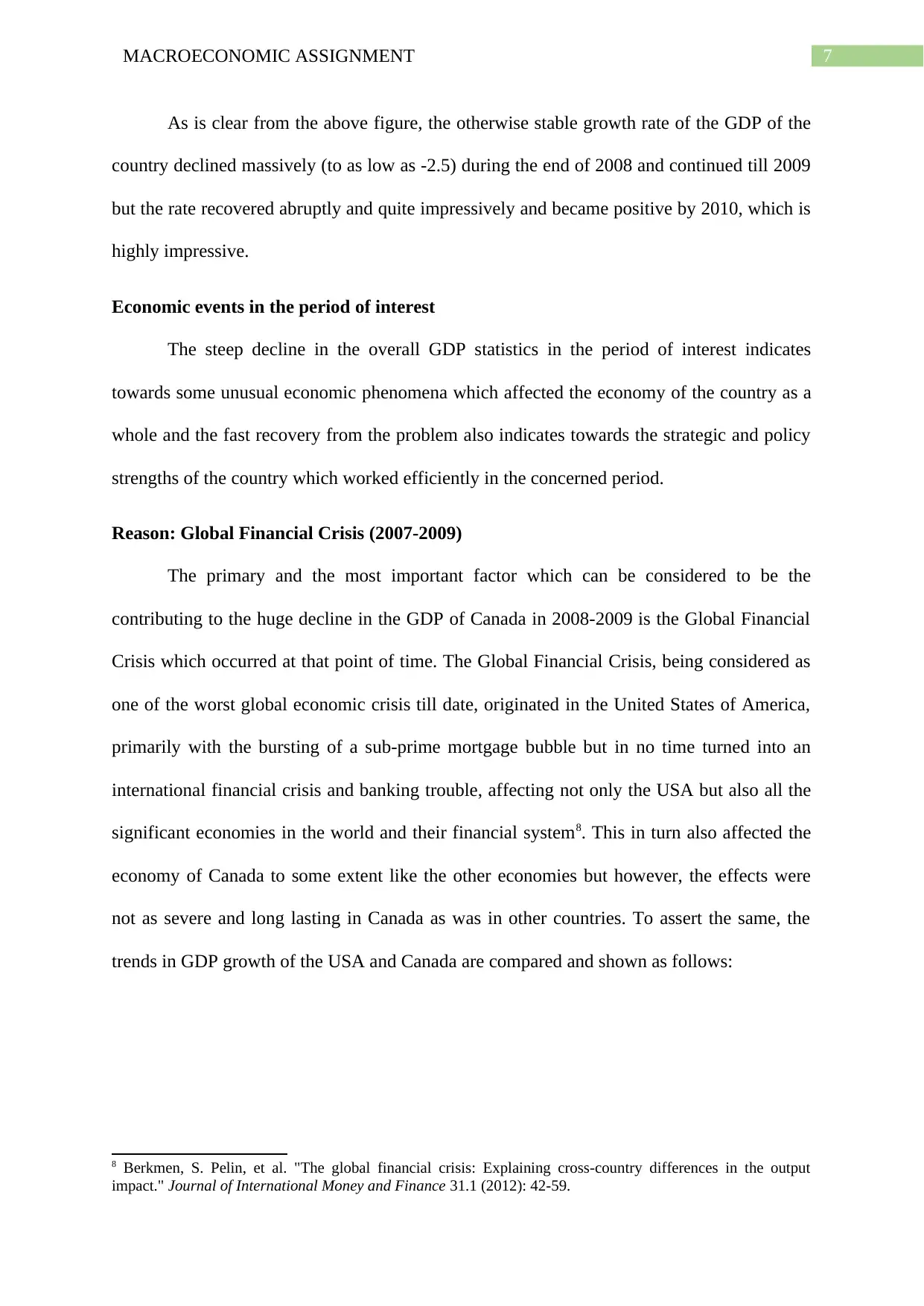
7MACROECONOMIC ASSIGNMENT
As is clear from the above figure, the otherwise stable growth rate of the GDP of the
country declined massively (to as low as -2.5) during the end of 2008 and continued till 2009
but the rate recovered abruptly and quite impressively and became positive by 2010, which is
highly impressive.
Economic events in the period of interest
The steep decline in the overall GDP statistics in the period of interest indicates
towards some unusual economic phenomena which affected the economy of the country as a
whole and the fast recovery from the problem also indicates towards the strategic and policy
strengths of the country which worked efficiently in the concerned period.
Reason: Global Financial Crisis (2007-2009)
The primary and the most important factor which can be considered to be the
contributing to the huge decline in the GDP of Canada in 2008-2009 is the Global Financial
Crisis which occurred at that point of time. The Global Financial Crisis, being considered as
one of the worst global economic crisis till date, originated in the United States of America,
primarily with the bursting of a sub-prime mortgage bubble but in no time turned into an
international financial crisis and banking trouble, affecting not only the USA but also all the
significant economies in the world and their financial system8. This in turn also affected the
economy of Canada to some extent like the other economies but however, the effects were
not as severe and long lasting in Canada as was in other countries. To assert the same, the
trends in GDP growth of the USA and Canada are compared and shown as follows:
8 Berkmen, S. Pelin, et al. "The global financial crisis: Explaining cross-country differences in the output
impact." Journal of International Money and Finance 31.1 (2012): 42-59.
As is clear from the above figure, the otherwise stable growth rate of the GDP of the
country declined massively (to as low as -2.5) during the end of 2008 and continued till 2009
but the rate recovered abruptly and quite impressively and became positive by 2010, which is
highly impressive.
Economic events in the period of interest
The steep decline in the overall GDP statistics in the period of interest indicates
towards some unusual economic phenomena which affected the economy of the country as a
whole and the fast recovery from the problem also indicates towards the strategic and policy
strengths of the country which worked efficiently in the concerned period.
Reason: Global Financial Crisis (2007-2009)
The primary and the most important factor which can be considered to be the
contributing to the huge decline in the GDP of Canada in 2008-2009 is the Global Financial
Crisis which occurred at that point of time. The Global Financial Crisis, being considered as
one of the worst global economic crisis till date, originated in the United States of America,
primarily with the bursting of a sub-prime mortgage bubble but in no time turned into an
international financial crisis and banking trouble, affecting not only the USA but also all the
significant economies in the world and their financial system8. This in turn also affected the
economy of Canada to some extent like the other economies but however, the effects were
not as severe and long lasting in Canada as was in other countries. To assert the same, the
trends in GDP growth of the USA and Canada are compared and shown as follows:
8 Berkmen, S. Pelin, et al. "The global financial crisis: Explaining cross-country differences in the output
impact." Journal of International Money and Finance 31.1 (2012): 42-59.
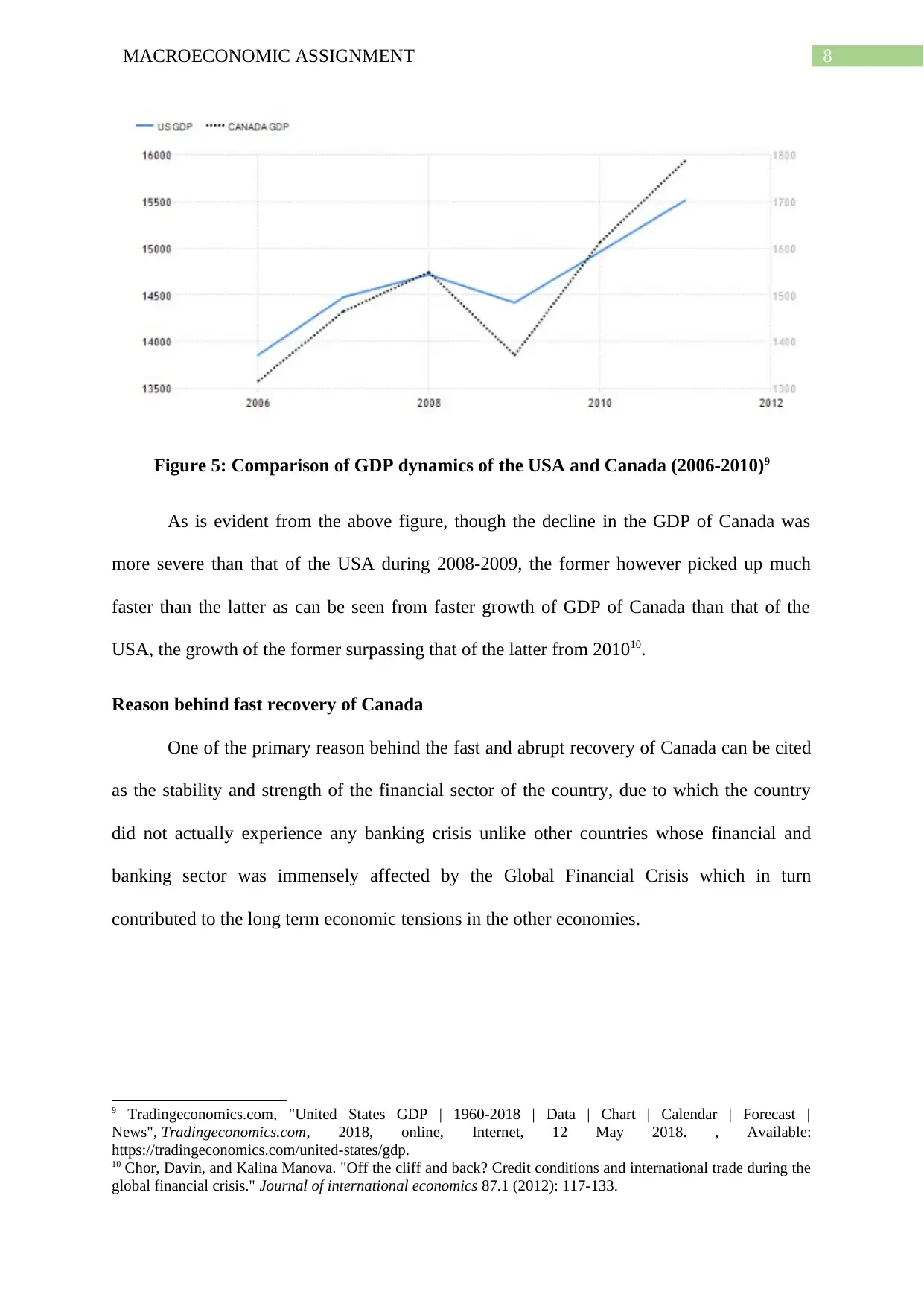
8MACROECONOMIC ASSIGNMENT
Figure 5: Comparison of GDP dynamics of the USA and Canada (2006-2010)9
As is evident from the above figure, though the decline in the GDP of Canada was
more severe than that of the USA during 2008-2009, the former however picked up much
faster than the latter as can be seen from faster growth of GDP of Canada than that of the
USA, the growth of the former surpassing that of the latter from 201010.
Reason behind fast recovery of Canada
One of the primary reason behind the fast and abrupt recovery of Canada can be cited
as the stability and strength of the financial sector of the country, due to which the country
did not actually experience any banking crisis unlike other countries whose financial and
banking sector was immensely affected by the Global Financial Crisis which in turn
contributed to the long term economic tensions in the other economies.
9 Tradingeconomics.com, "United States GDP | 1960-2018 | Data | Chart | Calendar | Forecast |
News", Tradingeconomics.com, 2018, online, Internet, 12 May 2018. , Available:
https://tradingeconomics.com/united-states/gdp.
10 Chor, Davin, and Kalina Manova. "Off the cliff and back? Credit conditions and international trade during the
global financial crisis." Journal of international economics 87.1 (2012): 117-133.
Figure 5: Comparison of GDP dynamics of the USA and Canada (2006-2010)9
As is evident from the above figure, though the decline in the GDP of Canada was
more severe than that of the USA during 2008-2009, the former however picked up much
faster than the latter as can be seen from faster growth of GDP of Canada than that of the
USA, the growth of the former surpassing that of the latter from 201010.
Reason behind fast recovery of Canada
One of the primary reason behind the fast and abrupt recovery of Canada can be cited
as the stability and strength of the financial sector of the country, due to which the country
did not actually experience any banking crisis unlike other countries whose financial and
banking sector was immensely affected by the Global Financial Crisis which in turn
contributed to the long term economic tensions in the other economies.
9 Tradingeconomics.com, "United States GDP | 1960-2018 | Data | Chart | Calendar | Forecast |
News", Tradingeconomics.com, 2018, online, Internet, 12 May 2018. , Available:
https://tradingeconomics.com/united-states/gdp.
10 Chor, Davin, and Kalina Manova. "Off the cliff and back? Credit conditions and international trade during the
global financial crisis." Journal of international economics 87.1 (2012): 117-133.
⊘ This is a preview!⊘
Do you want full access?
Subscribe today to unlock all pages.

Trusted by 1+ million students worldwide
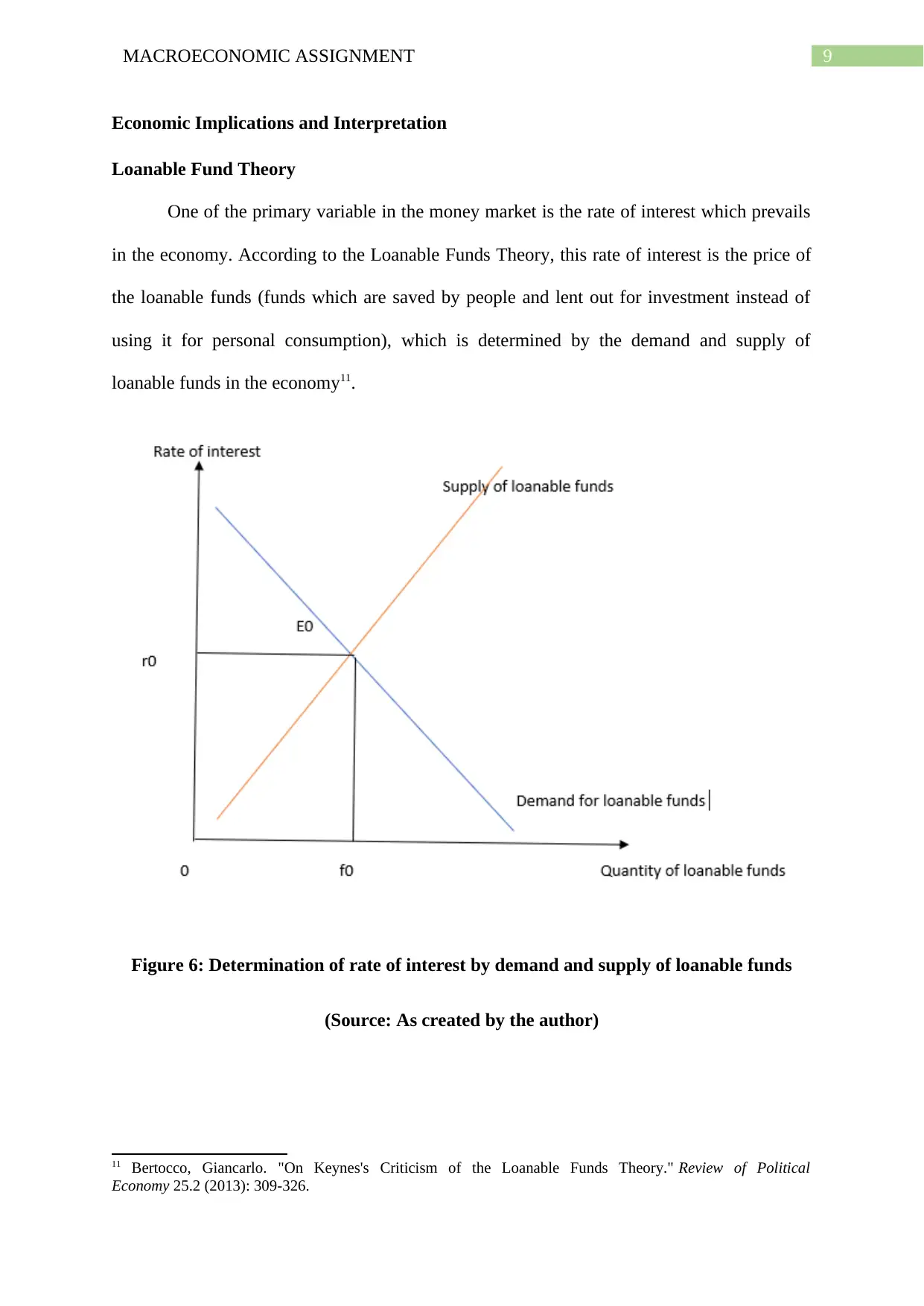
9MACROECONOMIC ASSIGNMENT
Economic Implications and Interpretation
Loanable Fund Theory
One of the primary variable in the money market is the rate of interest which prevails
in the economy. According to the Loanable Funds Theory, this rate of interest is the price of
the loanable funds (funds which are saved by people and lent out for investment instead of
using it for personal consumption), which is determined by the demand and supply of
loanable funds in the economy11.
Figure 6: Determination of rate of interest by demand and supply of loanable funds
(Source: As created by the author)
11 Bertocco, Giancarlo. "On Keynes's Criticism of the Loanable Funds Theory." Review of Political
Economy 25.2 (2013): 309-326.
Economic Implications and Interpretation
Loanable Fund Theory
One of the primary variable in the money market is the rate of interest which prevails
in the economy. According to the Loanable Funds Theory, this rate of interest is the price of
the loanable funds (funds which are saved by people and lent out for investment instead of
using it for personal consumption), which is determined by the demand and supply of
loanable funds in the economy11.
Figure 6: Determination of rate of interest by demand and supply of loanable funds
(Source: As created by the author)
11 Bertocco, Giancarlo. "On Keynes's Criticism of the Loanable Funds Theory." Review of Political
Economy 25.2 (2013): 309-326.
Paraphrase This Document
Need a fresh take? Get an instant paraphrase of this document with our AI Paraphraser
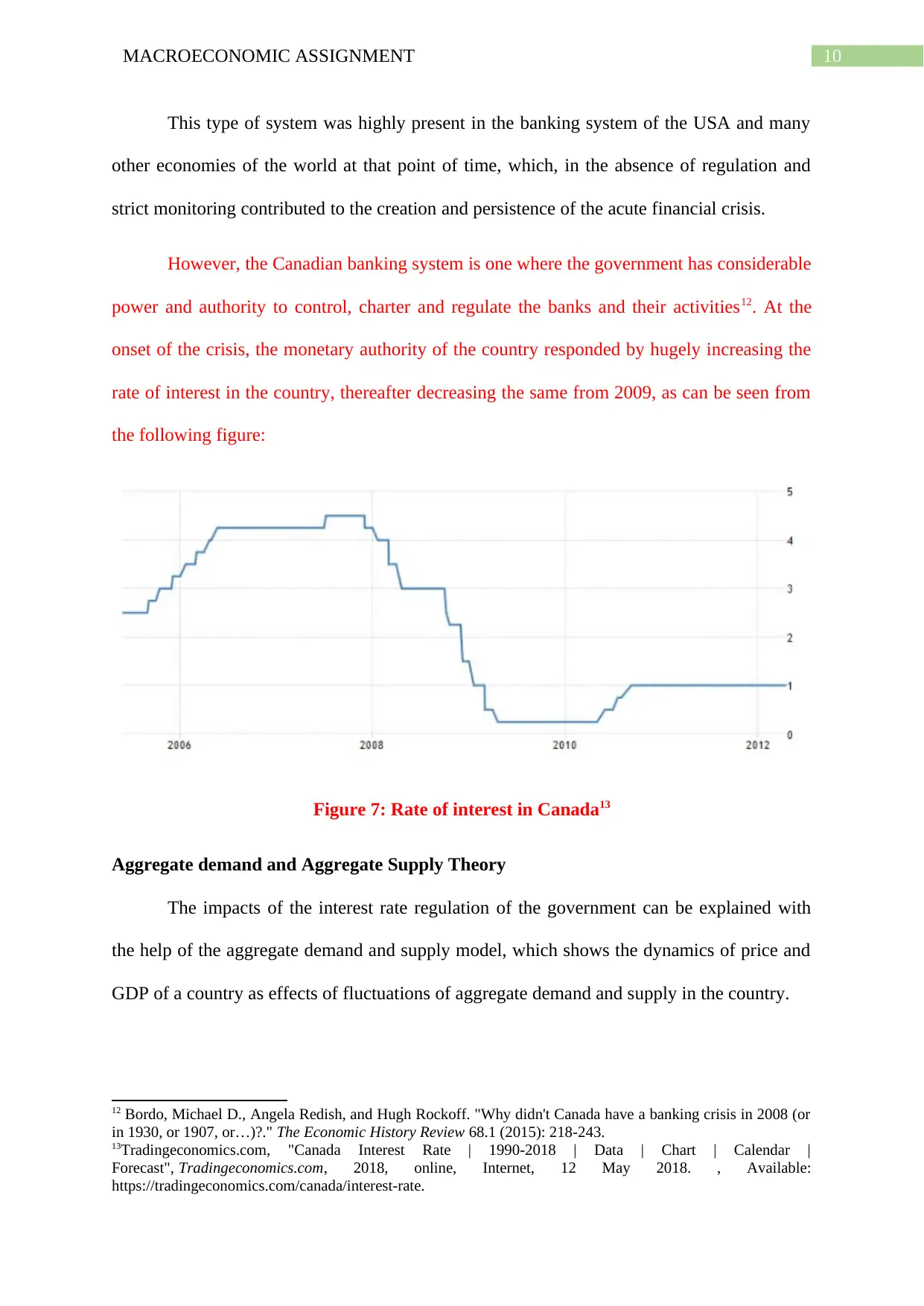
10MACROECONOMIC ASSIGNMENT
This type of system was highly present in the banking system of the USA and many
other economies of the world at that point of time, which, in the absence of regulation and
strict monitoring contributed to the creation and persistence of the acute financial crisis.
However, the Canadian banking system is one where the government has considerable
power and authority to control, charter and regulate the banks and their activities12. At the
onset of the crisis, the monetary authority of the country responded by hugely increasing the
rate of interest in the country, thereafter decreasing the same from 2009, as can be seen from
the following figure:
Figure 7: Rate of interest in Canada13
Aggregate demand and Aggregate Supply Theory
The impacts of the interest rate regulation of the government can be explained with
the help of the aggregate demand and supply model, which shows the dynamics of price and
GDP of a country as effects of fluctuations of aggregate demand and supply in the country.
12 Bordo, Michael D., Angela Redish, and Hugh Rockoff. "Why didn't Canada have a banking crisis in 2008 (or
in 1930, or 1907, or…)?." The Economic History Review 68.1 (2015): 218-243.
13Tradingeconomics.com, "Canada Interest Rate | 1990-2018 | Data | Chart | Calendar |
Forecast", Tradingeconomics.com, 2018, online, Internet, 12 May 2018. , Available:
https://tradingeconomics.com/canada/interest-rate.
This type of system was highly present in the banking system of the USA and many
other economies of the world at that point of time, which, in the absence of regulation and
strict monitoring contributed to the creation and persistence of the acute financial crisis.
However, the Canadian banking system is one where the government has considerable
power and authority to control, charter and regulate the banks and their activities12. At the
onset of the crisis, the monetary authority of the country responded by hugely increasing the
rate of interest in the country, thereafter decreasing the same from 2009, as can be seen from
the following figure:
Figure 7: Rate of interest in Canada13
Aggregate demand and Aggregate Supply Theory
The impacts of the interest rate regulation of the government can be explained with
the help of the aggregate demand and supply model, which shows the dynamics of price and
GDP of a country as effects of fluctuations of aggregate demand and supply in the country.
12 Bordo, Michael D., Angela Redish, and Hugh Rockoff. "Why didn't Canada have a banking crisis in 2008 (or
in 1930, or 1907, or…)?." The Economic History Review 68.1 (2015): 218-243.
13Tradingeconomics.com, "Canada Interest Rate | 1990-2018 | Data | Chart | Calendar |
Forecast", Tradingeconomics.com, 2018, online, Internet, 12 May 2018. , Available:
https://tradingeconomics.com/canada/interest-rate.
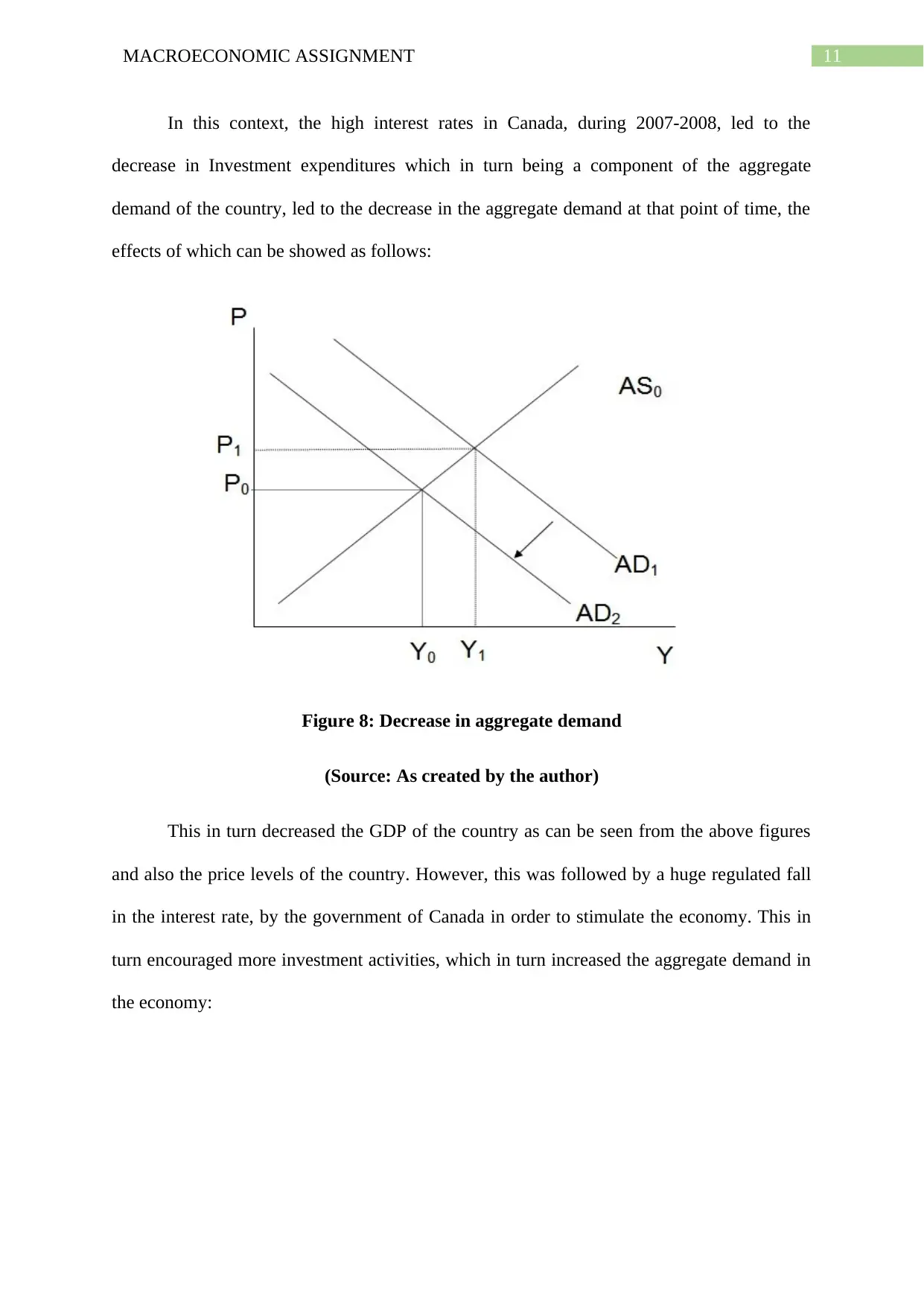
11MACROECONOMIC ASSIGNMENT
In this context, the high interest rates in Canada, during 2007-2008, led to the
decrease in Investment expenditures which in turn being a component of the aggregate
demand of the country, led to the decrease in the aggregate demand at that point of time, the
effects of which can be showed as follows:
Figure 8: Decrease in aggregate demand
(Source: As created by the author)
This in turn decreased the GDP of the country as can be seen from the above figures
and also the price levels of the country. However, this was followed by a huge regulated fall
in the interest rate, by the government of Canada in order to stimulate the economy. This in
turn encouraged more investment activities, which in turn increased the aggregate demand in
the economy:
In this context, the high interest rates in Canada, during 2007-2008, led to the
decrease in Investment expenditures which in turn being a component of the aggregate
demand of the country, led to the decrease in the aggregate demand at that point of time, the
effects of which can be showed as follows:
Figure 8: Decrease in aggregate demand
(Source: As created by the author)
This in turn decreased the GDP of the country as can be seen from the above figures
and also the price levels of the country. However, this was followed by a huge regulated fall
in the interest rate, by the government of Canada in order to stimulate the economy. This in
turn encouraged more investment activities, which in turn increased the aggregate demand in
the economy:
⊘ This is a preview!⊘
Do you want full access?
Subscribe today to unlock all pages.

Trusted by 1+ million students worldwide
1 out of 24
Related Documents
Your All-in-One AI-Powered Toolkit for Academic Success.
+13062052269
info@desklib.com
Available 24*7 on WhatsApp / Email
![[object Object]](/_next/static/media/star-bottom.7253800d.svg)
Unlock your academic potential
Copyright © 2020–2025 A2Z Services. All Rights Reserved. Developed and managed by ZUCOL.




